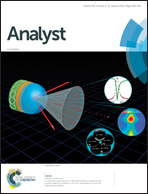Ultra-facile and rapid colorimetric detection of Cu2+ with branched polyethylenimine in 100% aqueous solution†
Abstract
The detection of copper ion (Cu2+) has become a long-term and arduous task in the field of environmental monitoring and human health. Current methods based on branched polyethylenimine (BPEI) for the detection of Cu2+ more or less suffer from being time-consuming and having a high cost or complex surface modifications. Herein, an ultra-facile and rapid colorimetric method was explored to detect Cu2+ in 100% aqueous solution by a direct format using only BPEI. Cu2+ could be captured by BPEI and form BPEI–Cu2+ complexes, which resulted in a color change from colorless to blue within 5 s, associated with the strong absorption peak at 278 nm. The lower the molecular weight and the concentration of BPEI are, the lower the detection limit is. When the molecular weight and the concentration of BPEI were 600 and 21.5 mg L−1, respectively, the detection limit was calculated to be 1.21 μM, and the linear range was 2 μM to 50 μM. Besides, BPEI also had an excellent selectivity toward Cu2+. This ultra-facile, rapid and inexpensive method offers great potential for various applications in biomedicine, environmental protection, food safety and so on.



 Please wait while we load your content...
Please wait while we load your content...